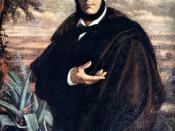An incredibly large object washes toward the shore. Not until the floating mass washes ashore, do the children realize that this is a man, a drowned man. At first, the children amused themselves by playing with the body, burying the corpse, digging it up and re-burying it over and over. Men from the village noticed their play and alerted the others in the village.
The body was taken into the village, laid out on the floor, and upon examination, the villagers realized that he was a stranger, not from their village. The corpse was huge, taking up most of the room, much larger than any of the men in the village. He was a giant.
Women began the task of cleaning the stranger, removing the remains of the sea from his face and body. Soon after the women began cleaning the stranger, they saw that he was, in the words of Marquez, the strongest, tallest, most virile man that they had ever seen.
They named him Esteban. Naming the drowned stranger made him theirs; much like naming a stray dog establishes ownership and responsibility. Once you take in a stray and provide him a name, you are responsible for his care and his fate. The women of the village, upon learning that Esteban was not one of the men from any of the neighboring villages exclaimed," Praise the lord, he's ours!" The transformation had taken place. The stranger was one of them and theirs to care for, their responsibility. The men of the village however were anxious to rid themselves of the stranger, now that they had determined that he was not a neighbor, a citizen of a nearby village. One of the women, despairing the lack of concern for the welfare of Esteban shown by the men, removed...


